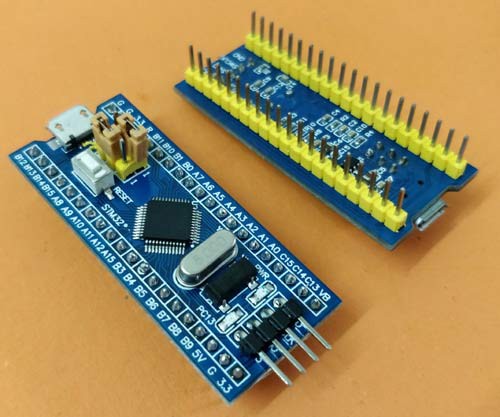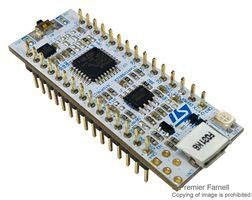Raspberry Pi Pico
Good support, not suited for low power (>180µA deep sleep)Blackpill
Upgrade to Bluepill.Bluepill

- More info about debugging
- Small
- Bread board friendly : fits on a 2x20pin, 0.6" row spacing socket
- Cheap, around €1.5
- low quality
- some components need to be replaced (to fix USB enumeration, to fix RTC)
- low power possible
- no embedded ST-Link that consumes power
- replace LDO for low power
- Supported by platformio (64KB max. code size by default, but with platformio it seems to work to upload, debug and run programs > 64KB)
- external ST-Link needed for debugging
- no wireless connectivity
- old MCU (RTC is only a simple counter, no calendar functionality)
- Black pill seems to be a performance upgrade to this one.
Nucleo 32

Why Nucleo32?
- Small, the 2x15pins fits in a 2x16 0.6" row spacing IC-socket (Digikey 2057-ICS-632-T-ND)
- Apparently pin-compatible to Arduino Nano. To be confirmed.
- 3V3, which is easier to interface to other electronics than the 5V boards.
- Integrated ST-Link debugger. Reduces the mess-o'-wires on your breadboard.
- Cheap <€10 from official sources (Digikey etc.)
- Good build quality, unlike the Chinese boards where you have to replace components that had the wrong value, are less-functional clones or that were otherwise unsuitable.
- A whole range of boards, with different MCUs. Some low power, some good processing capabilities.
- Good documentation
- Supported by PlatformIO (Arduino and other frameworks).
- Smaller than Blue Pill, but less GPIO pins
- Arduino Nano footprint compatible
- STM32Fxxx
variants not suited for low power. They need the clock signal from the ST-Link, e.g. if the UART baud rate is greater than 9600baud. - STM32Lxxx variants may be better for low power applications. To be investigated.
It might not be low power because of the integrated debugger. There might be ways to leave the debugger unpowered. These boards lack wireless connectivity.
ST-Link firmware
The ST-link firmware must be upgraded to make the virtual COM-port (VCP) work properly. The software to do this can be found on the ST-website. This should be the first thing you do with the Nucleo32 boards.
Variants
- NUCLEO-L432KC : 80MHz, 256KB flash, 64KB RAM, Arm ® Cortex ® -M4 32-bit MCU+FPU, TrustedParts (<€10)
- NUCLEO-F303K8 : STM32F303K8T6 72MHz, 12KB RAM, 64KB Flash
- Only 12K RAM
- 12bit DAC, maximum update frequency with Arduino analogWrite() is 87kHz (12bit) and 100kHz (8bit).
Default: A4 connected to D4, A5 connected to D5. - Only A3 works as DAC.
- 12bit ADC
- Arduino ADC-code is hopelessly inefficient : analogWrite(A3, analogRead(A6)); takes 208µs. Which means we could process real time audio with a maximum sampling frequency of 4.3kHz.
- Careful with D2 as IRQ-pin. I had problems with it on a SX1278. Not sure why. On the Nucleo32 schematic, there were no connections.
- Default pinning :
- SPI : D11, D12, D13
- User manual
 Christoph Tack
Christoph Tack
Discussions
Become a Hackaday.io Member
Create an account to leave a comment. Already have an account? Log In.